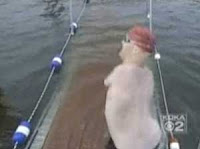" Cheryl Schiltz feels like she is perpetually falling. And because she feels like she is falling, she falls. When she stands up without support, she looks as if she were on a precipice, about to plummet. First her head wobbles and tilts to one side and her arms reach out to try to stabilise her stance. Soon her whole body is moving chaotically back and forth, like a person walking a tightrope in that frantic see-saw moment before losing his balance - except that both her feet are firmly planted on the ground, wide apart. When she tries to walk she has to hold on to a wall, and still she staggers like a drunk...
Cheryl's problem is that her vestibular apparatus, the sensory organ for the balance system, does not work [damaged by gentamicin]. Soon after her problem began, she lost her job as an international sales representative and now lives on a disability allowance of $1,000 a month. She has a new-found fear of growing old...
By any conventional standard, Cheryl's case is hopeless. The conventional view sees the brain as made up of a group of specialised processing modules, genetically hard-wired to perform specific functions. Once one of them is this damaged, it cannot be replaced. Now that her vestibular system is affected, Cheryl has as much chance of regaining her balance as a person whose retina has been damaged has of seeing again.
But today all that is about to be challenged. She is wearing a construction hat with holes in the side and a device inside called an accelerometer. Cheryl licks a thin plastic strip with small electrodes on it, and places it on her tongue. The accelerometer and the tongue strip are connected to a computer. This machine... will replace Cheryl's vestibular apparatus by sending balance signals to her brain from her tongue...
The first time they tried the hat, Cheryl wore it for only a minute. They noticed that after she took it off, there was a 'residual effect' that lasted about 20 seconds, a third of the time she wore the device. Then Cheryl wore the hat for two minutes and the residual effect lasted about 40 seconds. Then they went up to about 20 minutes, expecting a residual effect of just under seven minutes. But instead it lasted triple the time, a full hour...
It did keep up. Over the next year Cheryl wore the device more frequently to get relief and build up her residual effect, which progressed to multiple hours, to days, and then to four months. Now she does not use the device at all and no longer considers herself a Wobbler..."
The above is an extended abstract from a fascinating article at the
Telegraph (via
The New Shelton wet/dry) describing new insights into the plasticity of the human brain, and how essential functions can be recovered despite permanent structural damage. Even more impressive than the regained vestibular function is the subsequent one about regaining intellectual and motor function after a massive brainstem stroke. The Telegraph article is in turn extracted from
a book entitled 'The Brain That Changes Itself', by Norman Doidge (Penguin).

 Antimacassars are protective coverings placed over the back of a chair or sofa. "The original antimacassars were made of stiff white crochet-work, but later soft, coloured materials, such as embroidered wools or silks, were used. In the 20th century the use of antimacassars largely died out." The ones in the illustration are from the Palmer House in Chicago in 1875 (which, parenthetically, is where American Airlines boarded their crews when my mom was a stewardess for them in the early 1940s).
Antimacassars are protective coverings placed over the back of a chair or sofa. "The original antimacassars were made of stiff white crochet-work, but later soft, coloured materials, such as embroidered wools or silks, were used. In the 20th century the use of antimacassars largely died out." The ones in the illustration are from the Palmer House in Chicago in 1875 (which, parenthetically, is where American Airlines boarded their crews when my mom was a stewardess for them in the early 1940s).














































